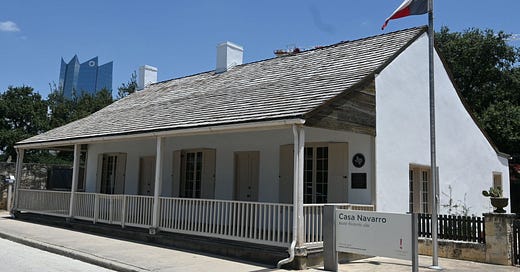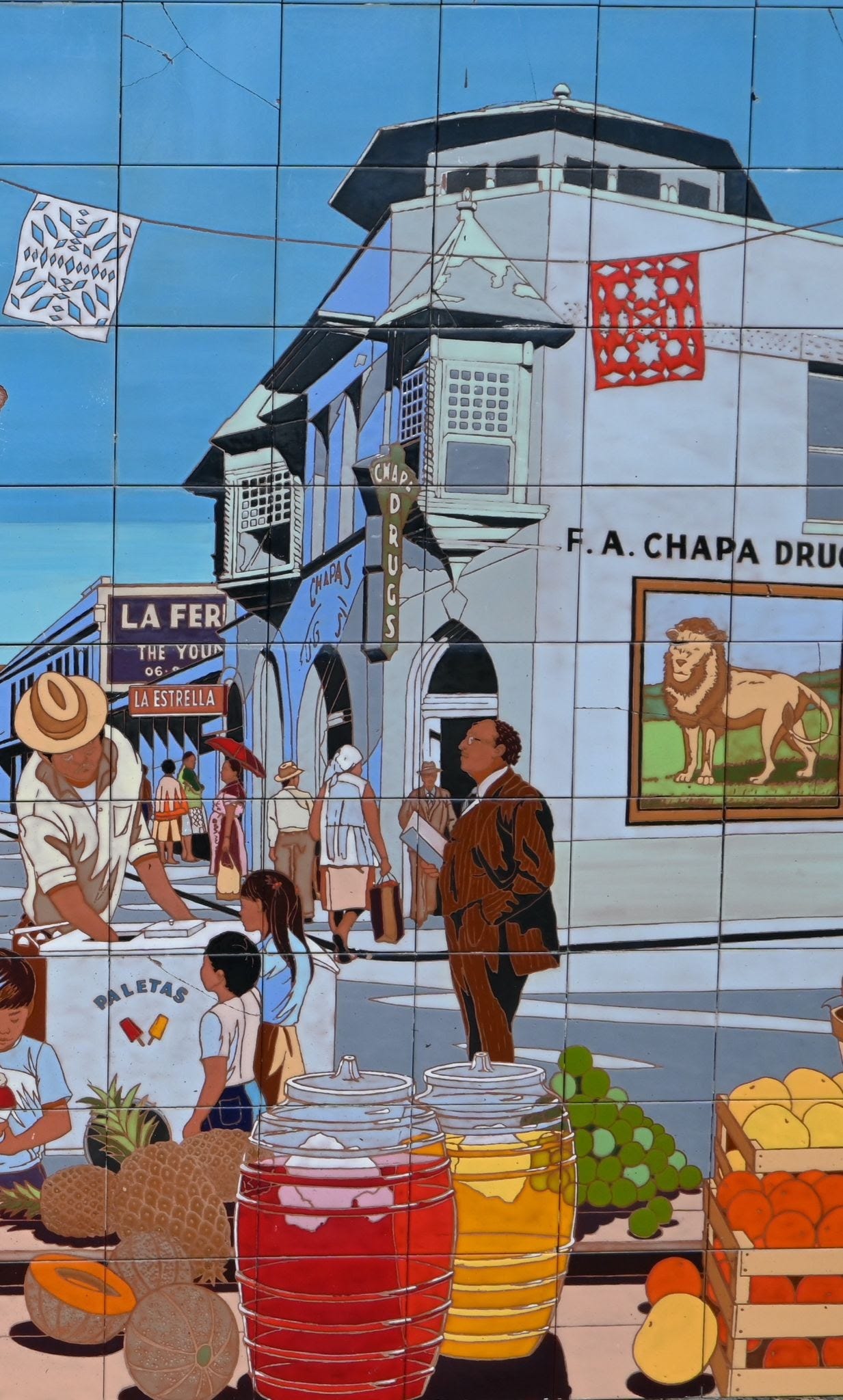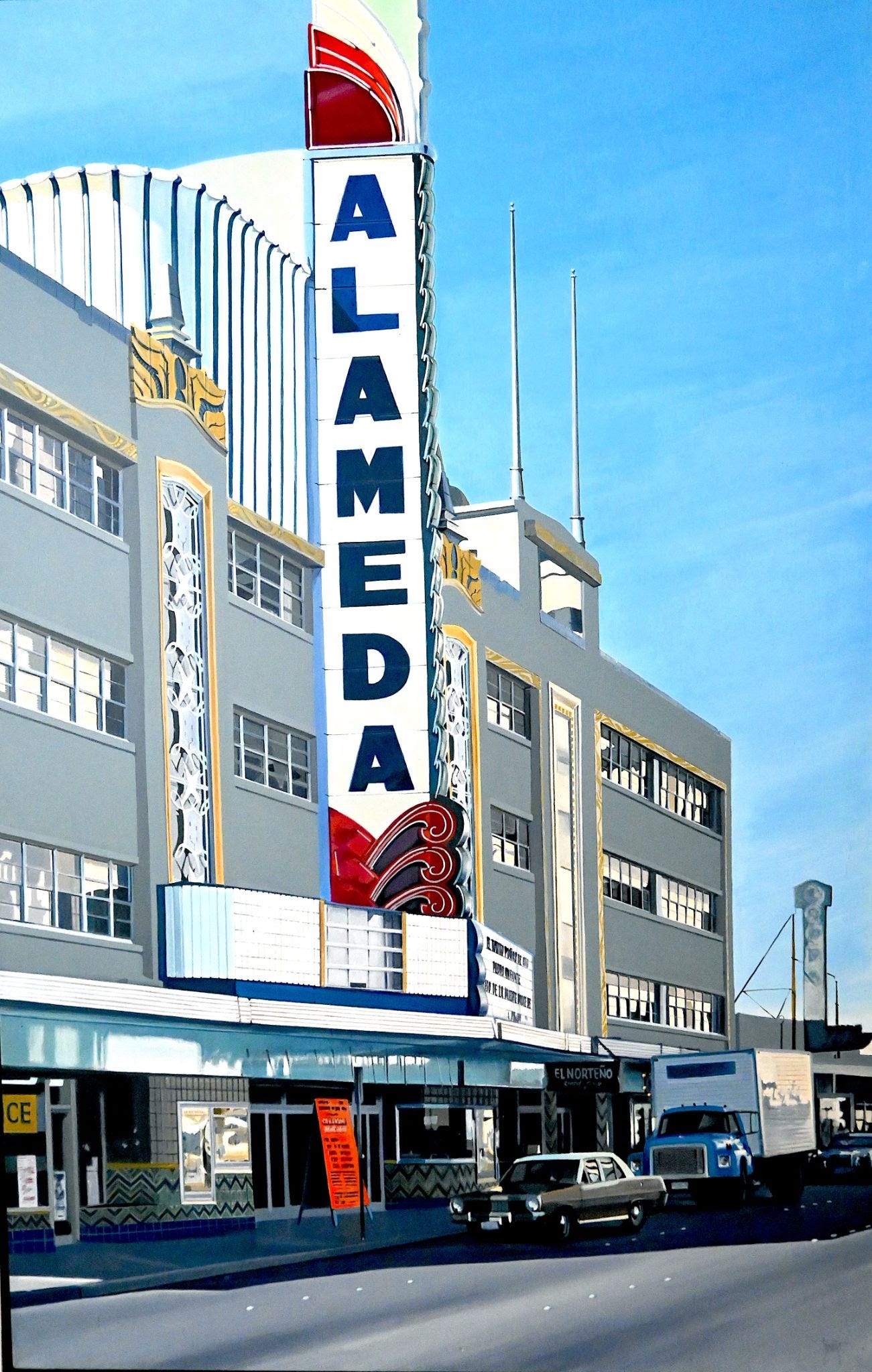A recent article in the New York Times, “Growth Tests a New San Antonio” by Patrick Sisson [Oct. 5, 2021], noted that “Some fear projects will threaten downtown’s Mexican American heritage.” The actual threat to the Mexican American communities of the downtown Mexican section of San Antonio is a more complicated story. The area’s demise occurred more than 60 years ago. This is an account of how “progress” completely and sadly transformed a thriving Mexican barrio next to downtown in the short span of twenty years from 1940-1960.
The historic home of Jose Antonio Navarro on Nueva Street near downtown San Antonio. Frost Building in the background. Photo by Ricardo Romo.
I am a native San Antonian. After living in Los Angeles and San Diego, I returned to my hometown 22 years ago. I grew up in the Westside barrio of the city, the area across the tracks west of the Southern Pacific Railroad and near the massive Interstate Highway 35 that separated the Westside from downtown in 1960.
Growing up in the 1950s in the Westside I witnessed the final decade of the downtown Laredito Barrio west of San Pedro Creek extending north and south between the streets of Martin and Laredo. The area comprised a thriving community just blocks away from City Hall and the Bexar County Courthouse located a short distance away from the center of town. My father, Henry Romo, Sr., was born in that community. His family lived near the railroad tracks that divided the Mexican downtown from the Mexican Westside. This barrio was one of the first communities of San Antonio where Spanish mestizo colonists built their homes west and south of San Fernando Cathedral in the mid-1700s.
Although few of the original Spanish colonial houses survived into the 20th century, they were replaced by many smaller homes of adobe construction. One of those homes built over 150 years ago still stands--that of Jose Antonio Navarro on Nueva Street a few hundred feet from the new Federal Court House. The area surrounding Navarro’s home had also been a preferred neighborhood for the descendants of the Canary Islanders who arrived in San Antonio in the 1730s.
One of the first urban communities of Mexican mestizos emerged a few blocks to the west, across the San Pedro Creek. That community was also within walking distance of downtown and the City Hall.
I knew this community, a classic urban barrio, as I often joined my father or grandfather as we visited the area to shop, attend movies, and visit friends. My dad owned a small grocery store in the Westside across the tracks. He bought his fresh vegetables and fruits for the store at the city’s major produce market, El Mercado, located in downtown Laredito.
Bird’s Eye of La Placita [Plaza del Zacate], Chapa Drugs, [right side] and El Nacional [left side]. From the postcard collection of Tim Palomera.
Also popular with my grandparents was Chapa’s Farmacia, a Mexican cultural institution on the corner of Santa Rosa and Commerce across the street from the famed Teatro Nacional in this same downtown area. Francisco Chapa, a native of Matamoros, studied pharmacy at Tulane University and moved to San Antonio in 1888 to open his own pharmacy. Chapa died in 1924, but his son kept the business going until 1960. The La Botica del Leon, as the Chapa pharmacy was known because of the large lion painted on the side of the building, faced Santa Rosa Street and was a bedrock of the old downtown Mexican barrio.
Details from a Jesse Trevino ceramic mural. The mural in the old Mercado center includes an image of Chapa Drugs. Located on Dolorosa St. near Santa Rosa St. Photo by Ricardo Romo.
Chapa became a respected pharmacist in the Westside, but he was best known for his political activities. From 1888 to 1906 Chapa served as a member of the local board of education. He was also elected alderman [city council member] and served for at least two terms. He was the publisher of El Imparcial de Texas, a conservative Spanish-language newspaper, that was favorable to the Mexican dictator Porfirio Diaz. Chapa is credited with helping Oscar B. Colquitt win the Mexican vote in San Antonio in a winning campaign for governor of Texas. Chapa was rewarded with a position as a “lieutenant colonel” on the governor’s staff.
Jesse Trevino oil painting of the Alameda. Permission courtesy of Jesse Trevino. Special thanks to Ernest Bromley and Otis Parchman. Photo: Ricardo Romo
Across from the Farmacia Chapa was a competitor, La Botica Guadalupana, owned by Daniel and Velia San Miguel. Located on Santa Rosa street and Produce Row, La Botica was best known for its excellent variety of Mexican herbs. My grandparents, who bought their herbs from the San Miguels, also knew this Mexican section of downtown from an earlier era when they bought tacos, tamales, and menudo from the famed Chili Queens. The “Queens” sold their homemade foods in the open space once reserved for oxen-driven wagons.
My father and grandfather also frequently ventured across the street to “La Placita,” the Mexican park downtown across from the pharmacies and the city produce market. La Placita was where the famous singer Lydia Mendoza was discovered in the 1930s and where Emma Tenayuca, began to organize pecan shellers during the same era.
In the book, Lydia Mendoza: A Family Autobiography, Mendoza recalled her visits to “La Plaza del Zacate” across the street from the produce market and near the Teatro Nacional. Mendoza recalled that “There were a lot of groups performing in the Plaza, but they were all men. We were women; we were the only women singers: my mother, my sister, and I.”
The old Mexican downtown San Antonio was also home to the Spanish-language theaters La Alameda on Houston Street and El Nacional and La Zaragoza on Commerce Street between the city’s produce market and San Fernando Cathedral. Almost everything west of San Pedro Creek prior to 1960 reflected Mexican American culture. The Mexican community’s most popular stores, “tienditas,” Mexican bakeries, the famed Casa Blanca Mexican restaurant, and the bilingual newspaper La Prensa were all located within a block of one another in Laredito near Market Square. This commercial center was within walking distance of the center of downtown. Unfortunately, with the exception of La Alameda, the popular Mexican movie theaters have all been demolished.
Teatro Nacional on the corner of Commerce and Santa Rosa St. Next door to the right on Commerce St. is the Zaragoza theater. Special thanks to Tim Palomera.
The Mexican American community surrounding the present-day Market Square represented one of the oldest barrios of the Southwest. The displacement of barrio residents began in the 1940s and continued to the early 1960s. My family, which settled in that area in 1917, originally lived near the downtown Market Square and like many others displaced from that area, moved west across the tracks to the Westside. Their story is not unique.
The threat of gentrification continues in low-income Latino and Black neighborhoods in major cities across the U.S. Residents and community activists, as well as preservation scholars, must be vigilant in their efforts to protect cultural heritage.








Very nice article. We have two other Mexican theaters. The Aztec and the Guadalupe.